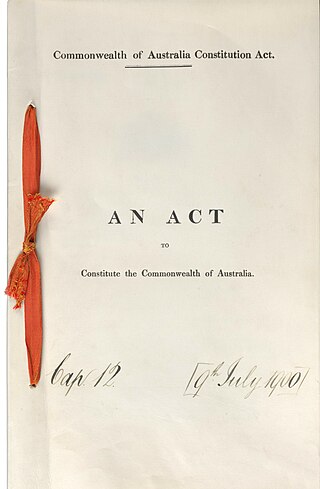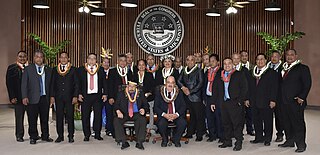A constitutional amendment is a modification of the constitution of a polity, organization or other type of entity. Amendments are often interwoven into the relevant sections of an existing constitution, directly altering the text. Conversely, they can be appended to the constitution as supplemental additions, thus changing the frame of government without altering the existing text of the document.

The Spanish Constitution is the supreme law of the Kingdom of Spain. It was enacted after its approval in a constitutional referendum; it represents the culmination of the Spanish transition to democracy. It is a written constitution.

The Oregon Constitution is the governing document of the U.S. state of Oregon, originally enacted in 1857. As amended the current state constitution contains eighteen sections, beginning with a bill of rights. This contains most of the rights and privileges protected by the United States Bill of Rights and the main text of the United States Constitution. The remainder of the Oregon Constitution outlines the divisions of power within the state government, lists the times of elections, and defines the state boundaries and the capital as Salem.
Article IV, Section 1 of the United States Constitution, the Full Faith and Credit Clause, addresses the duty that states within the United States have to respect the "public acts, records, and judicial proceedings of every other state". According to the Supreme Court, there is a difference between the credit owed to laws as compared to the credit owed to judgments. Judges and lawyers agree on the meaning of the clause with respect to the recognition of judgments rendered by one state in the courts of another. Barring exceptional circumstances, one state must enforce a judgment by a court in another, unless that court lacked jurisdiction, even if the enforcing court otherwise disagrees with the result. At present, it is widely agreed that this clause of the Constitution has a minimal impact on a court's choice of law decision provided that no state's sovereignty is infringed, although this clause of the Constitution was once interpreted to have greater impact.
The Constitution Alteration Bill 1974, was an unsuccessful proposal to alter the Australian Constitution to make it easier to amend the constitution and give voters in the Australian territories the right to vote in referendums. It was put to voters for approval in a referendum held on 18 May 1974.
The Constitution of Arkansas is the primary organizing law for the U.S. state of Arkansas delineating the duties, powers, structures, and functions of the state government. Arkansas' original constitution was adopted at a constitutional convention held at Little Rock in advance of the territory's admission to the Union in 1836. In 1861 a constitution was adopted with succession. After the American Civil War its 1864 constitution was drafted.An 1868 constitution was passed to comply with the Reconstruction acts. The current constitution was ratified in 1874 following the Brooks–Baxter War.
State ratifying conventions are one of the two methods established by Article V of the United States Constitution for ratifying proposed constitutional amendments. The only amendment that has been ratified through this method thus far is the 21st Amendment in 1933.

Parliamentary elections were held in the Federated States of Micronesia on 8 March 2005, alongside a three-part referendum. As no political parties existed, all 23 candidates for the 10 available seats in Congress ran as Independents.
The Constitution of the State of Maine established the "State of Maine" in 1820 and is the fundamental governing document of the state. It consists of a Preamble and ten Articles (divisions), the first of which is a "Declaration of Rights".

The Constitution of the State of Nevada is the organic law of the state of Nevada, and the basis for Nevada's statehood as one of the United States.

The Constitution of the State of Colorado is the foundation of the laws and government of the U.S. state of Colorado. The Colorado State Constitution was drafted on March 14, 1876; approved by Colorado voters on July 1, 1876; and took effect upon the statehood of Colorado on August 1, 1876. As of 2020, the constitution has been amended at least 166 times. The Constitution of Colorado derives its authority from the sovereignty of the people. As such, the people of Colorado reserved specific powers in governing Colorado directly; in addition to providing for voting for Governor, state legislators, and judges, the people of Colorado have reserved initiative of laws and referendum of laws enacted by the legislature to themselves, provided for recall of office holders, and limit tax increases beyond set amounts without explicit voter approval, and must explicitly approve any change to the constitution, often with a 55% majority. The Colorado state constitution is one of the longest in the United States.
The Twenty-fourth Amendment of the Constitution Bill 2001 was a proposed amendment to the Constitution of Ireland to allow the state to ratify the Treaty of Nice of the European Union. The proposal was rejected in a referendum held in June 2001, sometimes referred to as the first Nice referendum. The referendum was held on the same day as referendums on the prohibition of the death penalty and on the ratification of the Rome Statute of the International Criminal Court, both of which were approved.

The Constitution of Australia is the fundamental law that governs the political structure of Australia. It is a written constitution, that establishes the country as a federation under a constitutional monarchy governed with a parliamentary system. Its eight chapters sets down the structure and powers of the three constituent parts of the federal level of government: the Parliament, the executive government and the judicature.

Proposition 8 of 1911 was an amendment of the Constitution of California that introduced, for the first time, the recall of public officials. This allows the governor, state senators and assemblymen, and other elected officials to be removed from office early by a public vote. It was approved by voters in a referendum held as part of a special election on 10 October. On the same day voters approved two other major political reforms, Proposition 4, which granted women the vote, and Proposition 7, which introduced the initiative and the optional referendum.

Parliamentary elections were held in the Federated States of Micronesia on 8 March 2011, alongside a three-part referendum. As there were no political parties, all 34 candidates ran as independents. For the first time in the country's history, two women ran for election, both in Chuuk State. However, neither was elected.

Parliamentary elections were held in the Federated States of Micronesia on 7 March 1989 alongside a referendum on electing a Constitutional Convention. All candidates for seats in Congress ran as independents. The referendum was held in compliance with article 2, section 9 of the constitution, which specified that there must be a referendum on convening a Constitutional Convention at least every ten years. It was approved by 71% of voters, and the Constitutional Convention election was subsequently held in 1990.

A six-part referendum was held in Palau on 2 November 2004 alongside the country's general elections. Voters were asked questions on summoning a Constitutional Convention, payment of members of the National Congress, creating a unicameral Congress, term limits for Congress members, election of the President and Vice President and dual citizenship. All proposals were approved except the unicameral Congress, which despite receiving a majority of the public vote, did not meet the quorum of 12 of 16 states required for amendments to the constitution.

A twenty-three-part referendum was held in Palau on 4 November 2008 alongside the country's general elections. Voters were asked questions on requirements of citizenship to hold office, government provision of primary school and health care, the definition of marriage and term limits for Parliament. Only the proposal permitting naturalization for certain adoptees failed to obtain the requisite majority of the vote and majority in 3/4th of the states.

A referendum on nine proposed amendments to the constitution was held in Micronesia on 4 July 2023. Eight of the amendments were proposed by the Constitutional Convention elected in 2019, and one amendment was proposed by Congress. All nine amendments passed, and were officially ratified by President Simina on 4 October 2023.
The Constitution of the State of Yap, one of the four states of the Federated States of Micronesia, is the fundamental legal text of the State of Yap. It was adopted in 1982, promulgated on December 24 of the same year and came into force on January 1, 1983. Amendments were adopted by referendum and promulgated on November 24, 2006. The constitution comprises 15 articles. It can be consulted in English on the website of the Supreme Court of the Federated States of Micronesia.











